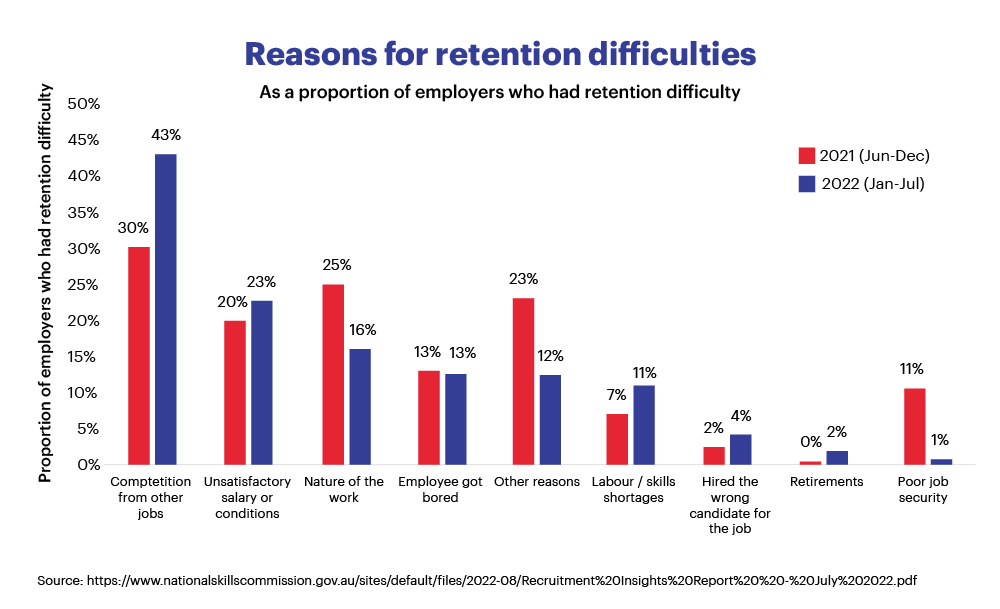Organisations globally are struggling to recruit quality talent in one of the most challenging recruitment markets we’ve ever seen. From difficulties sourcing quality candidates in budget to implementing initiatives to retain hard-working employees, there is currently a spotlight on the global recruitment market to find solutions that combat such difficulties.
In this blog, we discuss the 2022 recruitment challenges and how automation can help.
2022 recruitment challenges
If we take the Australian recruitment market as an example, in the year leading up to February 2022, 1.3 million people, or 9.5% of employed people changed jobs1. This is the highest annual job mobility rate Australia has seen since 2012. The effects of this have since spurred the growth of workplace phenomena supporting a change in working lifestyles.
In the National Skills Commissions’ Recruitment Insights Report July 20222, the main reason employers gave for having issues with retention was ‘competition from other jobs’, which increased from 30% in 2021 to 43% in 2022. Other popular reasons for retention difficulty included ‘unsatisfactory salaries or conditions’, 20% in 2021 to 23% in 2022, and ‘labour or skills shortages’, 7% in 2021 to 11% in 2022.

According to ABS’s Wage Price Index Report3 for the quarter ending June 2022, wages grew by 2.6%. This had a direct effect on employers and the noted rise in labour costs. With 81% of employers4 believing candidates have become more demanding with salary expectations compared to pre-pandemic conditions, candidates now have the power in the recruiter-candidate relationship.
Not only are salary requests increasing but so are general recruitment costs. In the 2022 HR Industry Benchmark Report5 conducted by ELMO Software and the Australian Human Resources Institute (AHRI), the cost to hire a single employee has more than doubled in a year from an average of $10,500 to $23,860 per candidate. The time to hire new employees has also increased to an average of 40 days for Australian employers recruiting in 2022, up from 33.4 days in 2021.
Recruitment challenge solution: automation
Let’s dig deep into an industry where 40%6 of an organisation’s overall recruitment is placed: contact centres. In Smaart Recruitment’s 2022 Contact Centre Best Practice Report6, the top two concerns for contact centre recruiters are the low volume of applicants and the salaries not being competitive enough to satisfy candidates. This is having a knock-on effect on how many individual vacancies a single recruiter is working at fulfilling.
With 32% of internal recruiters working on 50 or more vacancies at any one time, it’s no wonder they are struggling with heightened workloads. As unemployment and job seeker volumes decrease, many contact centres are actually reporting a decrease in the quality of candidates. In the report, only 15% of recruiters believe the quality of candidates has improved between January 2021 and now. A staggering 46% believe the quality significantly decreased during the same time period.
In terms of attrition rates, 52% of contact centres averaged attrition between 10% and 30%, with 61% of those moving externally or leaving the organisation. With 55% of contact centres spending roughly six to 12 weeks training and onboarding new agents7, these rising turnover rates can become problematic. In addition to this, less than 10% of contact centres say their agents reach proficiency in less than two months, with 42% taking around three months, and over a third taking six months.
To help offset the workload of contact centre agents and thereby reduce the overall number of agents needed. Oration by Convai takes care of some of the more repetitive and time-consuming contact centre activities. This in turn reduces recruitment hurdles and assists with retention by routing calls more effectively. From empowering your agents to work more productively and lowering costs, to creating the best customer experiences on the phone or through virtual agents.
With the help of Oration, your call centre agents will be at less risk of receiving complex calls as the plug-in uses a range of advanced features to route calls more effectively within your contact centre. Oration helps shorten average hold times by quickly identifying caller intent which then helps agents understand the purpose of a call and what to say or do next. By taking care of first point-of-contact queries, organisations can optimise contact centre training and recruitment to focus on specific skills that create the best customer experiences.
To learn more about how Oration can help businesses in times of contact centre recruitment difficulties, read our product brochure packed full of benefits, features and more.
References:
1. https://www.abs.gov.au/statistics/labour/jobs/job-mobility/latest-release
2. https://www.nationalskillscommission.gov.au/sites/default/files/2022-08/Recruitment%20Insights%20Rep...
3. https://www.abs.gov.au/statistics/economy/price-indexes-and-inflation/wage-price-index-australia/lat...
4. https://www.roberthalf.com.au/salary-guide
5. https://elmosoftware.com.au/resources/research-reports/2022-hr-industry-benchmark-report/
6. https://www.smaart.com.au/bestpractice2022
7. https://www.callcentrehelper.com/images/resources/2021/procedureflow-state-of-the-contact-centre-tra...



